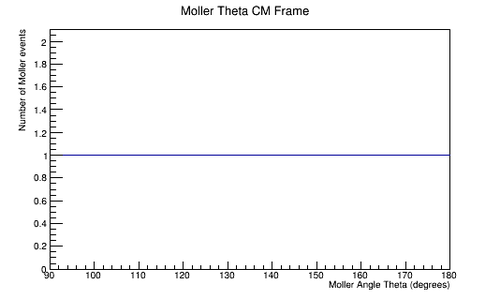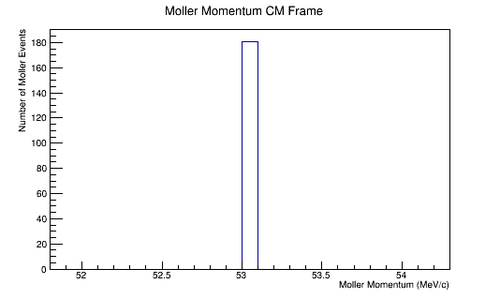Uniform distribution in Energy and Theta LUND files
4.1 Uniform Distribution in Energy and Theta LUND files
To ensure that all the electrons simulated in GEMC are Moller electrons, this is made easier by first creating them in the center of mass frame after scattering. In this frame, the Moller differential cross section is well defined, and can be used to ensure that all particles to be simulated will be Moller electrons. Due to the fact that GEMC simulations will utilize particle momentum in the lab frame, the LUND files must contain lab frame information. In addition, all the data given is for 11GeV electrons that have not yet had the chance to interact with the target material.
In the lab frame there are 2 degrees of freedom, i.e. and . The number of degrees of freedom can be reduced to 1 degrees of freedom in the center of mass frame of reference since the Moller differential cross section does not rely on . The simplicity of the center of mass frame for Moller electrons is that the interacting particles have equal energies and equal but opposite momentum vectors. In such a system where these conditions must be met, the directions of the momentum vectors must be opposite, which reduces the degrees of freedom to one direction. Since the Moller differential cross-section only relies on in all frames it implies for a given angle we should find the same results for any given angle .
To ensure that we can produce the Moller differential cross section in the center of mass frame we start with a uniform isotropic distribution of Moller electrons with respect to the scattering angle theta. From this distribution, each particle can be applied an appropriate weight that will result in the differential cross section being reproduced.
The LUND file is created by creating an isotropic distribution of electrons within the Moller center of mass frame of reference after scattering. These particles are uniformly distributed through the angle theta with respect to the beam line in the range 90-180 in the center of mass frame. This is initially done at a set angle phi (0 degrees) with respect to the perpendicular components with respect to the beam line.

